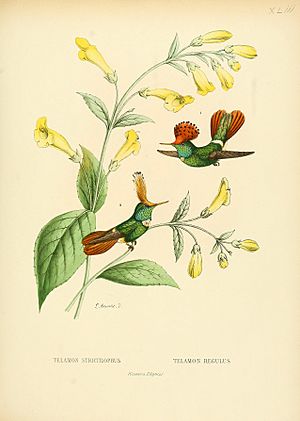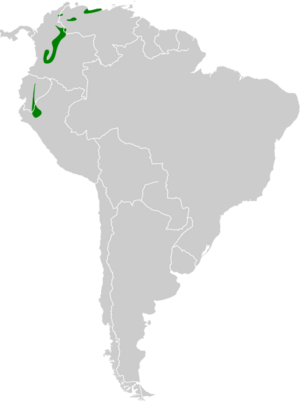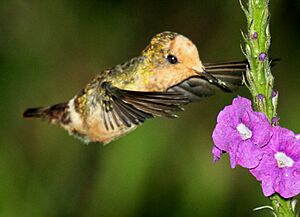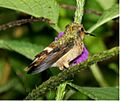Spangled coquette facts for kids
Quick facts for kids Spangled coquette |
|
|---|---|
 |
|
| Male, on the left | |
| Conservation status | |
| Scientific classification | |
| Genus: |
Lophornis
|
| Species: |
stictolophus
|
 |
|
The spangled coquette (Lophornis stictolophus) is a tiny, colorful hummingbird. It is known by other names too, like "coquette pailletée" in French. You can find this bird in parts of South America. It lives in countries like Brazil, Colombia, Ecuador, Peru, and Venezuela.
Contents
About the Spangled Coquette
How Scientists Classify This Bird
Scientists group living things to understand them better. This is called taxonomy. The spangled coquette is a type of hummingbird. It belongs to a group of hummingbirds called "coquettes." It is thought to be closely related to the short-crested coquette and the rufous-crested coquette. This bird is "monotypic," meaning it's the only species in its group.
What Does This Hummingbird Look Like?
The spangled coquette is a small bird. It is about 6.4 to 6.9 centimeters (2.5 to 2.7 inches) long. Both male and female birds have a short, straight, red beak with a black tip. Their upper bodies are a shiny bronzy-green. They also have a white band across their lower back.
- Male Spangled Coquette:
- Males have a short, bushy, reddish crest on their head. The tips of these feathers are black.
- They also have short, reddish and shiny green feathers on their cheeks. These look like little tufts.
- Their throat is a bright, shiny green. Some feathers have white tips.
- The rest of their underside is bronzy-green.
- Their middle tail feathers are green. The other tail feathers are reddish-brown with black tips.
- Female Spangled Coquette:
- Females do not have the crest or cheek tufts that males have.
- Their throat is whitish with large reddish spots.
- Their underside is cinnamon (a reddish-brown color). Often, they have green spots there.
- Their middle tail feathers are green. The other tail feathers are cinnamon with black bars and buff (pale yellowish-brown) tips.
Young birds look a lot like the adult females. However, their throat is usually grayish.
Where Does the Spangled Coquette Live?
This hummingbird lives in several South American countries. You can find it from western Venezuela down through eastern Colombia and Ecuador. It also lives in northern Peru and parts of Brazil.
It likes to live in certain places. These include the edges of humid forests and open areas within them. It also lives in a type of grassland called cerrado. Sometimes, it can be found in drier, scrubby areas. This bird can live at high places, up to 1,300 meters (about 4,265 feet) above sea level.
Spangled Coquette Behavior
How It Moves Around
The spangled coquette does not travel far. It stays in the same area for its whole life. This means it is a "sedentary" bird.
What It Eats
The spangled coquette mainly drinks nectar from many different kinds of flowers. It usually finds its food high up in the trees. We don't know all the details about what it eats. Sometimes, it will "borrow" nectar from the areas where larger hummingbirds feed. It also eats small arthropods, like insects. It catches these by waiting on a perch and then flying out to grab them in the air. This is called "hawking."
Life Cycle and Reproduction
Scientists do not know much about how the spangled coquette breeds. We don't have details about its nesting habits or when it lays eggs.
Sounds It Makes
The spangled coquette is usually a quiet bird. When it is feeding, it sometimes makes a short, sharp "tsip" sound. When it hovers in the air, its wings make a soft, low humming sound, like a bee.
Status of the Spangled Coquette
The IUCN is an organization that checks on animal populations. They first thought the spangled coquette was "Near Threatened." But since 2004, they have changed its status to "Least Concern." This means it is not currently in danger of disappearing.
We don't know exactly how many spangled coquettes there are. We also don't know if their numbers are growing or shrinking. It is generally a rare bird to see. However, there are no big dangers to it right now. It seems to be okay living in some areas changed by humans.
Images for kids





